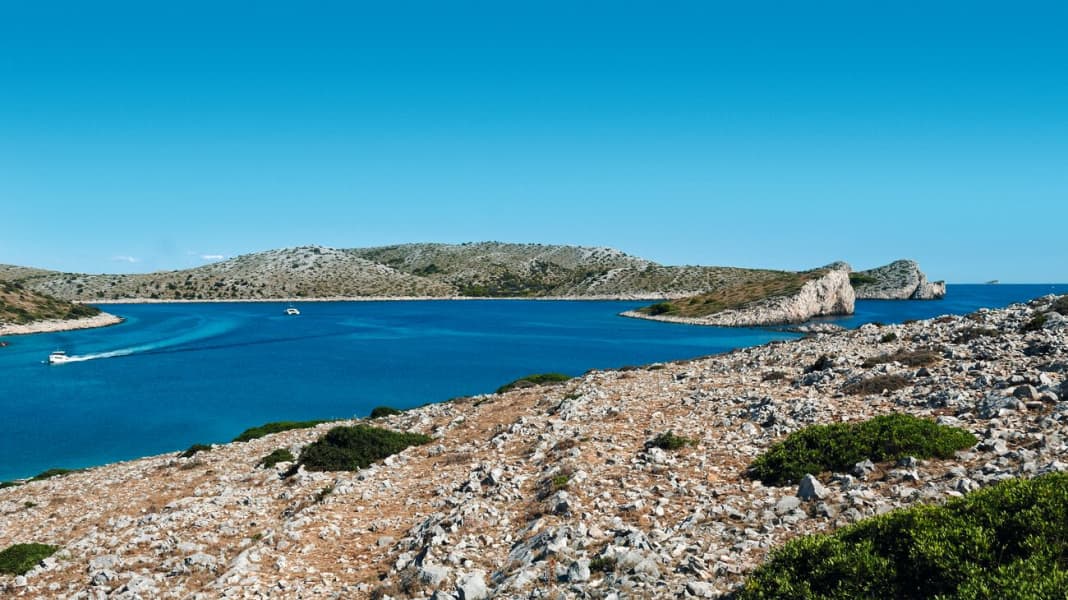
After the hustle and bustle of Zadar, we are now travelling to a completely different world - to the "stars in the sea", as BOOTE named the Kornati islands in 2019 in reference to George Bernard Shaw. This group of over 130 islands forms the southernmost part of an island chain and stretches from Zadar to Šibenik. The islands probably owe their fame to their unusual barrenness. If you are looking for something special, coupled with a dash of solitude, this is the place for you. Although the loneliness is probably on the wane - despite the sharp rise in entrance fees for sailing in the Kornati Nature Park. There are also several marinas and in many bays there are konobas - small restaurants offering typical local dishes.
Our first destination there is Marina Piškera, where the entrance fee to the nature park is already included in the mooring fee. We take our time and make a few detours to discover beautiful anchor bays and view the archipelago from the seaward side. Steep rocky coastlines with vertical cliffs and caves characterise the landscape. We are thrilled. This is how we hoped to start the second part of our cruise with "Azura" along the Croatian Adriatic coast. After the north (see BOOTE 6/22), we now have the south ahead of us.
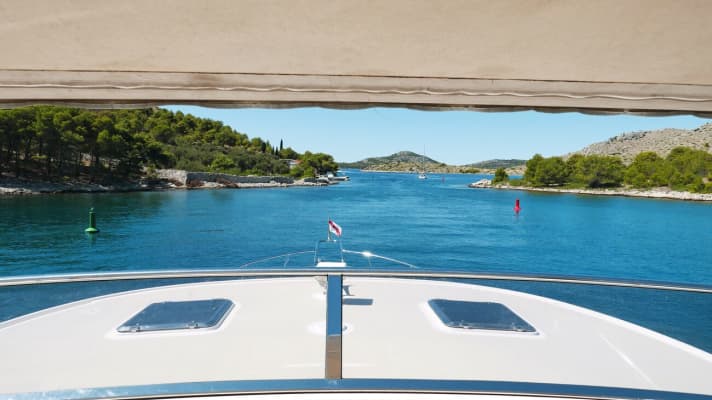
Marina Piškera is located at the very edge of the Kornati islands on the island of the same name. When we arrive there in the early afternoon, there is hardly a boat in the harbour and you get the feeling of being on the edge of civilisation. In the afternoon and evening, however, the marina fills up noticeably, with sailors setting the tone. We receive a friendly welcome and enjoy the deceptive luxury of being moored with two additional side mooring lines alongside the two mooring lines at the bow. This completely superfluous advantage in the prevailing conditions will give us a headache.
The next morning, as we cast off in glorious weather conditions, one of the side mooring lines gets caught in our port propeller. Before I realise it, the line is wound up and the engine stops on its own. Now we're stuck, and good advice is expensive because there's no diver available in this marina. Finally, one of the marineros agrees to at least dive under the ship to see what's going on. The result is sobering: the mooring line has wrapped itself around the shaft and the propeller and is bombproof. What to do? We cut it in several dives, using our serrated bread knife to good effect. Now we can at least continue to the next larger harbour with one engine. Still in the Kornati islands, we call Marina Mandalina in Šibenik. They have a telephone number ready, and the diver there later turns out to be an absolute professional. With an oxygen tank on his back, he gets to work. As time goes by, more and more cut-out line arrives on the floating dock. There is also a piece that has already been plasticised by the frictional heat, but fortunately it is so small that it can still be easily removed. Finally, the shaft is free. The relief and joy is great, despite the considerable total bill.
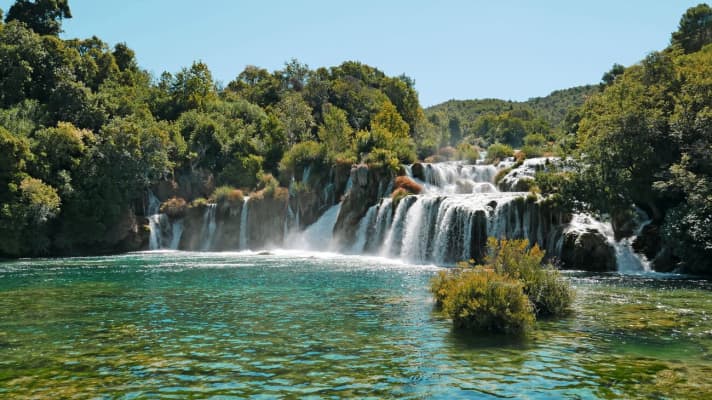
So we head inland to the famous waterfalls on the River Krka. It winds its way through lakes and gorges until we reach the picturesque village of Skradin. Squeezed between the mountains, there are a surprising number of large ships moored at the quay and in the marina. Numerous restaurants show that there is a lot going on here: excursion boats leave every hour for the waterfalls in Krka National Park. There, the river cascades over several terraces and plunges some 45 metres into the depths. For this reason, Croatia's first hydroelectric power station was built here in 1895 - only shortly after the world's first large-scale power station at Niagara Falls.
The next day belongs to Šibenik, whose Italian character is unmistakable. The old town can be explored by climbing 2800 steps through narrow alleyways. The most important monument is the late Gothic Cathedral of St James, whose roof consists of a barrel vault with cantilevered stone slabs. Šibenik is full of life and yet has many quiet, romantic corners. You only have to stray a few metres from the tourist paths to find yourself in another world.
Our next destination is Trogir, another completely unknown place with a great past and present. During the journey, the wind picks up strongly, as it has done a few times before, until it is constantly blowing at five Beaufort. We mainly have it from astern, but the boats coming towards us have to put up with a bit more swell and spray. Trogir is a very popular port of call, so we are lucky to get a berth - this time alongside a floating jetty, where mooring lines are usually used. From the aft deck, we have a direct view of the old town and the Kamerlengo fortress. Simply beautiful.
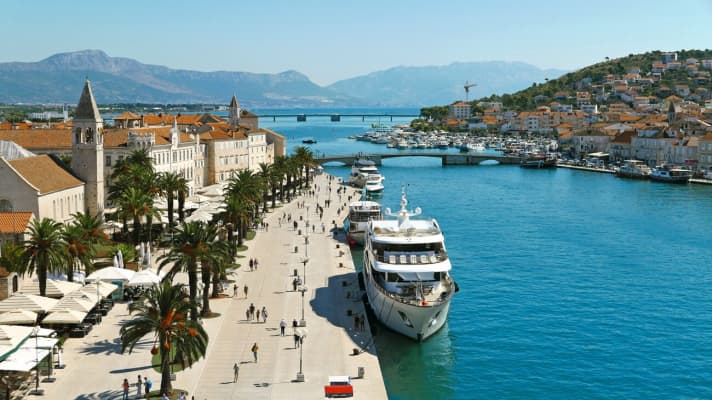
Instead of going straight to Split, we head for the beautiful little town of Milna on the offshore island of Brač - not by a direct route, however, but by travelling south around the island of Šolta. Detours are not a burden here, but a pleasure. And from Brač it is only a comfortable stone's throw, so we decide to sail around the "Bay of Forts" and try to identify the seven remaining examples from the water. It's not easy, as the old fortifications have often become one with the surrounding buildings, but we manage.
The city of Split with its airport is a hub for cruisers, ferries to the offshore islands and numerous charter companies. In the harbour you can constantly see people streaming to and from the ships with wheeled suitcases or sailing bags. The water in the huge harbour bay is constantly in turmoil due to the incoming and outgoing ships. The swell thumps against the concrete piers until late in the evening. But of course Split has more to offer than just hustle and bustle. The origins of the city can be traced back to the famous Diocletian's Palace from Roman times, which has been a UNESCO World Heritage Site since 1979.
We now set off for Vrboska marina on the island of Hvar. Instead of taking the shortest route, we head eastwards around the island of Brač in front of it. On the way, we briefly call at the village of Pučišća, which is well sheltered at the end of a long bay. The entrance to the harbour can be seen from a great distance, as this is where the large limestone quarry is located, which is of great importance to the history of the village. On the northern shore of the harbour pier is the stonemasonry school founded in 1906 - the only one in Croatia. It is said that even part of the White House in Washington was built using local limestone - who knows...
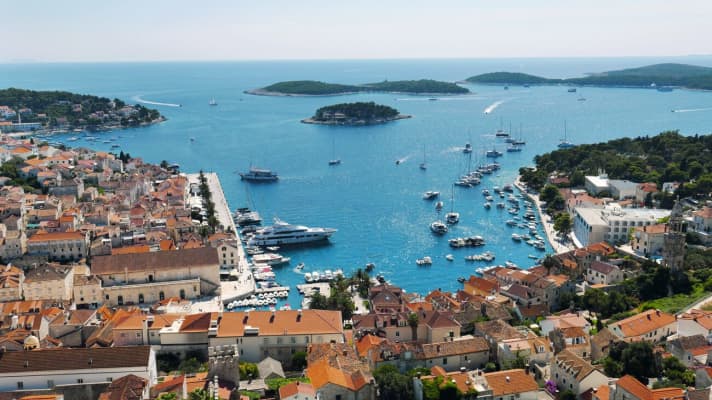
As we set course for Vrboska in the north of Hvar after rounding the eastern end of Brač, the westerly wind blows unchecked through the Hvarski Kanal between Brač and Hvar, creating a certain swell. The sailors around us are making great speed. In the natural bay of Vrboska, however, the wind drops considerably. As we walk to dinner, we see two brightly painted VW Beetles that can be hired as convertibles. The next morning, I'm standing in front of the landlord's door, which is already open, and we soon come to an agreement. Just like in our student days, we speed across the island, whose tourist epicentre is located in the eponymous main town of Hvar, with the roof down and our arms hanging out casually. The impressive and very well-preserved Španjola, the Spanish Fortress, towers above the harbour. From here you have a fantastic view of the offshore Pakleni Islands, whose geometry from above is somewhat reminiscent of some circular Kornati islands.
We pass the Pakleni Islands and head out to sea. The western tip of Korčula is only about 15 nautical miles away, so the contours of the mountain silhouette are already clearly recognisable. Our excellent "Coastal Handbook Croatia" does not yet list a marina in Vela Luka, but there has been one there for about a year: Marina Korkyra. A lot of concrete was used for the piers of the marina and at the same time a rather unorthodox layout was realised. Presumably the conditions here in winter in the bay, which is open to the west, make such massive protection necessary.
The main town of Korčula is at the other end and bears the same name as the island itself. Here, for the second time on our trip, we get a mooring cancellation and move to neighbouring Lumbarda. There is room for us there and we enjoy the trip along the south coast. At the beginning of the route, we took the opportunity to sail behind the numerous small offshore islands and once again discovered quiet little spots and bays. If you approach Lumbarda from the west, as we do, the mountains of the Pelješac peninsula gradually rise up behind Korčula.
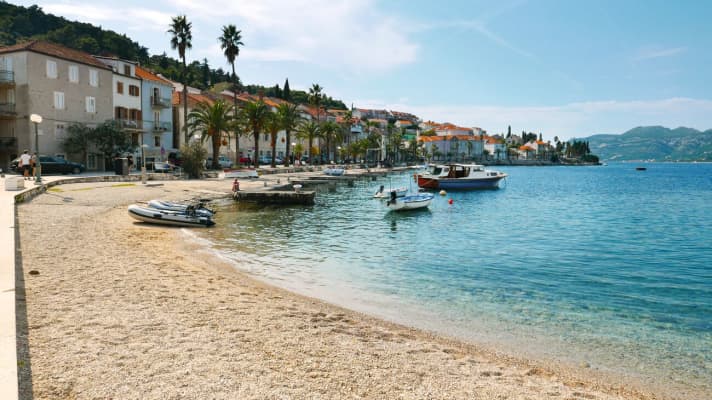
We visit Korčula by dinghy. Situated on a small peninsula, the old town fulfils every wish a tourist might have. It has been beautifully restored and is frequented by ferries, yachts and excursion boats alike. We quickly realised why we couldn't get a berth there. The ACI Marina Korčula is being extensively expanded to accommodate more and larger boats. Incidentally, Korčula sells itself as the birthplace of Marco Polo, although this is by no means historically proven. However, this does not detract from our enjoyment and does not change our admiration for this great Venetian traveller.
At my wife's special request, we next set our sights on the so-called honey island of Mljet. There are no marinas here, but there are numerous islands and bays, some with buoys or small moorings. The konobas (tavernas) on the water also offer moorings with mooring lines, which are free of charge if you stop for a bite to eat. We have not yet tested this with our boat size, so it remains to be seen where we will spend the next night. On the way, we see dolphins again, who let us get very close without diving straight away. Apparently, the bay of Pomena is also equipped for our boat size, as the mooring lines are long and strong enough.
Mljet is particularly famous for its shimmering green inland lake, which in turn has a small island on which the Benedictines built an abbey in the 12th century. Today, the ensemble is one of the largest cultural monuments in Croatia. We then glide almost silently across the lake on a solar-powered catamaran to the former monastery, where an almost enraptured atmosphere surrounds the visitor. Back in Pomena, we dine in front of the stern of our "Azura" in the Konoba Ribar and, in addition to the delicious food, enjoy a first-class sunset. With no wind at all and the air like velvet, we feel like we're in the antechamber to paradise.
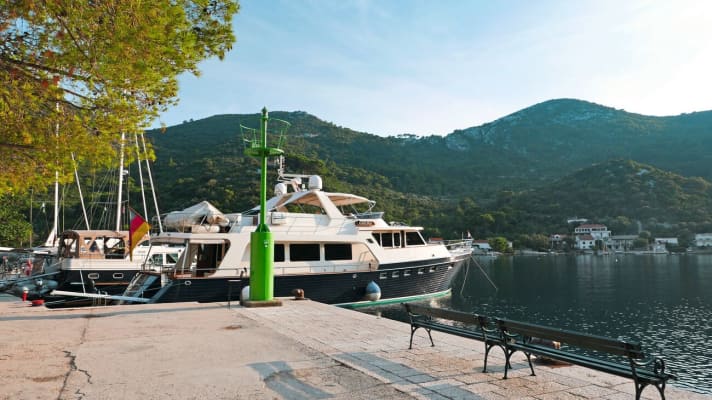
As we have planned enough time, we leisurely trundle through the Dalmatian islands and enjoy nature. You constantly discover new perspectives and beautiful landscapes. We chose Luka Sipanska bay for the next night. The island of Sipan belongs to the Elaphite Islands and is home to the nationally renowned Kod Marka restaurant in this well-protected, romantic bay. The restaurant's own buoys are already fully booked at lunchtime, but we are lucky enough to get a table for the evening.
On the last stage, we circle the Elaphite Islands before setting course for Dubrovnik. The high cable-stayed bridge over the River Ombla - one of the shortest navigable rivers in Europe at just four kilometres in length - can be seen from afar. The ACI marina is idyllically situated at its end, surrounded by steep, predominantly green mountains. On the opposite bank is a Franciscan monastery, which can be visited and is illuminated at night. Dubrovnik's old town is a good distance to the east of the modern centre. It makes a powerful impression even from the sea. We begin to understand why it attracts hordes of tourists every year. The perfect programme for our last day in Croatia. We walk along the completely preserved city wall, which surrounds the entire old town centre with several fortified towers. As it was built on an imposing rock base at different heights, the wall also leads up and down, allowing for constantly changing motifs, panoramas and perspectives. After six fantastic weeks, these are worthy final impressions of a unique journey.
Together with "Azura", we now only have the comparatively short journey to the winter camp in Montenegro ahead of us. We will continue our journey next summer. What will follow the anteroom to paradise? We will see.
You will find the travel report "Into the South" in BOOTE issue 09/2022. From 17 August 2022 at newsstands, online directly in the Delius Klasing Shop - and already here.

